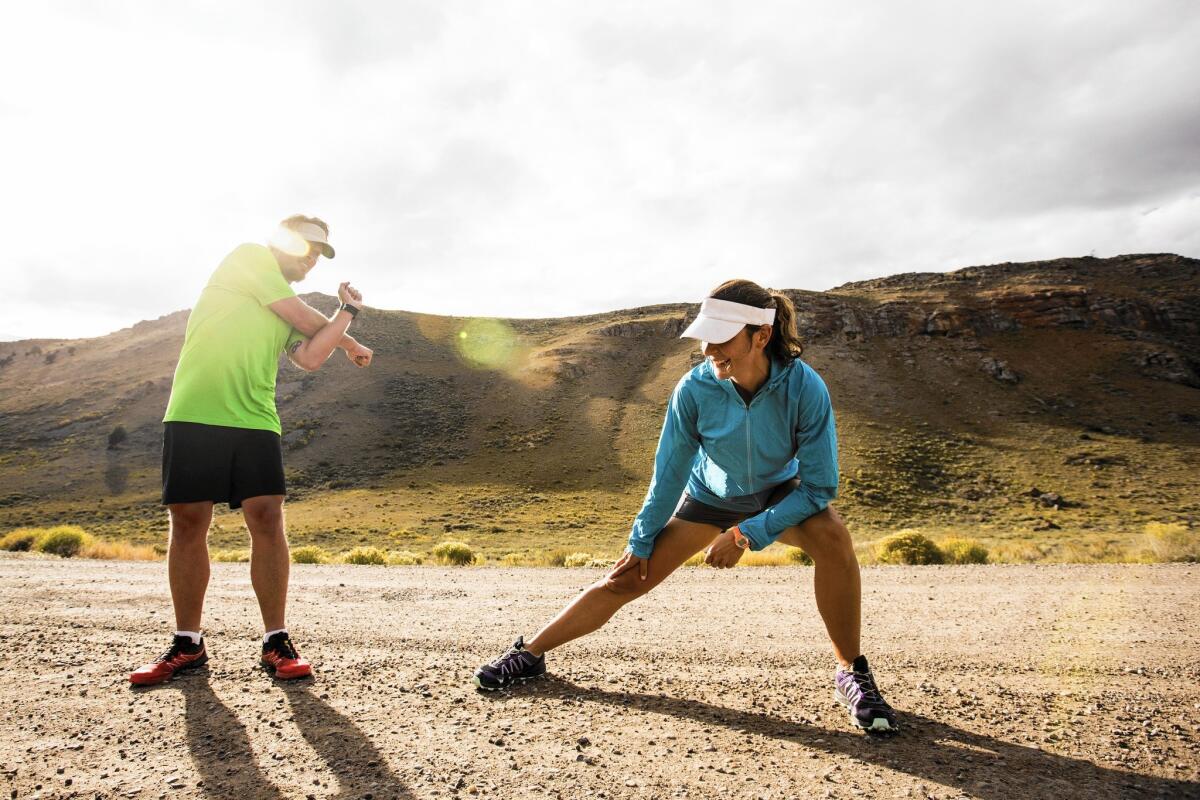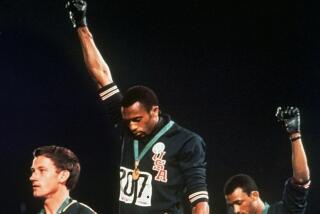Did you know stretching before exercise is controversial? Here’s the right way to do it:

- Share via
By Roy M. Wallack
Some experts say stretching before exercise helps performance and lessens injuries. But, believe it or not, others say stretching does the opposite.
Who’s right?
Proponents point to people who can’t afford to be wrong: Athletes.
The Clippers stretch before every game. And Meb Keflezighi, an Olympic silver medalist and the 2014 Boston Marathon winner, stretches before every run.
“Stretching restores your tightened connective tissue to normal length and puts your joints in correct alignment. That lets you go faster and avoid injury,” said physical therapist Robert Forster, founder of Phase IV performance lab in Santa Monica.
So what to make of studies that claim the opposite — that stretching actually takes the spring out of your step and puts joints at risk by over-loosening them?

The Clippers have been stretching at least since 2011 as seen in this photo where Blake Griffin gets some help with stretching at the end of practice.
Evidence can be traced back to two 2013 studies that found that extensive pre-exercise “static” stretching (in which stretches are held in a fixed position for a minute or so) done “cold” — without a warmup — hurt the performance of weight lifters and competitive athletes.
One of those two studies, published in the Journal of Strength and Conditioning Research, found that the maximum weight fit young men could hoist after static stretching versus after no stretching was 8.3% less. The other study, published in the Scandinavian Journal of Medicine and Science in Sports, found an overall strength decline in some athletes who used stretching as their only warmup. It concluded that static stretching should not be used as the sole warmup activity.
These findings seem to validate the anti-stretching camp. But they may be sounding a false alarm. Experts who work with pro athletes question the way the studies were carried out and insist that stretching is beneficial.
“These studies often put subjects in unrealistic situations that do not reflect what works in the field,” said Dennis Colonello, the Clippers’ team chiropractor.
Before a game, the Clippers do short-duration stretching — not intense, yoga-style static stretches. And that is part of an extensive, hours-long warmup that includes skipping rope, running on treadmills and shooting. Ten minutes before game time, players go through a formal group stretch led by the strength coach.
“They don’t hold each stretch for more than a few seconds,” says Colonello. “They’ll pull halfway and release. That activates the muscle and gets the joints loose, but not too loose. Longer stretching and yoga is fine for recovery on off-days.”
This pattern — short, light stretches as part of an active warmup before an event and long, static stretching afterward and the next day — is the general rule for many top athletes.
“I stretch before my warmup — a five-to-seven minute routine while I’m drinking my white tea in the morning,” says Keflezighi, whose recent book, “Meb for Mortals,” includes stretching-and-flexibility routines customized to the type of workout planned. “I don’t hold the stretches too long or push too deep; that’ll get me too loose and will cause a loss of elasticity.” He then uses a foam roller for deep tissue massage for a few minutes before hitting the pavement for a slow, three-minute warmup run.
Only then does Keflezighi do his full running workout.
After his workout, the San Diego-based 40-year-old does 60-second-long static stretches, followed by a core workout. On recovery days, he’ll often take a full yoga class.
The true goal of stretching is not to warmup or mentally prepare you for your workout, although it may help to do that, Forster said. “It’s to align your bones just right so that they move through the joints with natural biomechanics.”
Tips for short, light stretches in warmup
Until the experts agree about the finer points of stretching, we’ll follow the lead of many top athletes and engage in short, light stretches as part of an active warmup before an event — like the Los Angeles Marathon.
And we’ll leave the long, static stretching for afterward and the next day.
We asked physical therapist Robert Forster, founder of Phase IV performance lab in Santa Monica, whose team is also the physical therapy provider of the Los Angeles Marathon, for tips on getting a great full body stretch that you can do anytime, anywhere.
He suggests 18 stretches, seven for the upper body, and 11 for the lower body. Some of them you might recognize from the gym or a yoga class, such as an overhead tricep stretch or a “press up.” Others, such as something called the “pretzel,” are likely to be new. You can see the stretches in action at his website: phase-iv.net/Articles/ForsterTrainingSystemsStretches
A few tips: Proceed gently, just until you feel a comfortable stretch. Greater flexibility comes with practice. And if a stretch seems too challenging, skip it until you gain that greater flexibility. After all, if you hurt yourself stretching, you’ll be relegated to the sidelines.
— Rene Lynch






